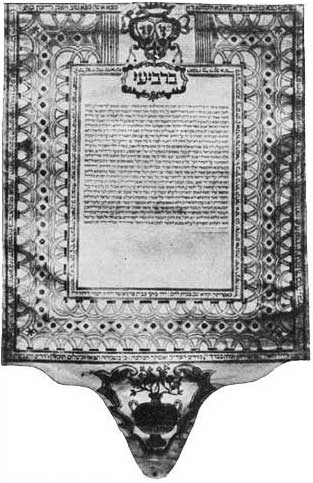History of Ketubot
 Videos:
Videos:
The ketubah (marriage contract) is a legal document that is written in Aramaic the technical language of Talmudic law and the popular language of the time it first emerged (eighth century BCE or BC). The ketubah is an agreement drafted and signed by two witnesses that testifies that the husband guarantees he will provide his wife with necessary conditions of life such as clothing and shelter, as well as a specified sum in the case of divorce, or her inheritance if he should predecease her. The purpose of the ketubah is to protect the wife and provide her with a safeguard to prevent divorce against her will.
 A document like the ketubah was first introduced during the time of Babylonian captivity (597-537 BC). This document became proof of the purity of the family in a time of increasing intermarriage between Jews and non-Jews. The Book of Tobit (a part of the Hebrew Apocrypha or religious books not in the Jewish Bible) makes a clear mention of a marriage contract, which probably was an early predecessor of the ketubah.
A document like the ketubah was first introduced during the time of Babylonian captivity (597-537 BC). This document became proof of the purity of the family in a time of increasing intermarriage between Jews and non-Jews. The Book of Tobit (a part of the Hebrew Apocrypha or religious books not in the Jewish Bible) makes a clear mention of a marriage contract, which probably was an early predecessor of the ketubah.
Jewish law requires every married couple to have a ketubah, and it must be replaced if the original document is lost or misplaced. The ketubah is read during the Jewish wedding ceremony and after it is read by the rabbi or other qualified individual it is handed to the husband who then hands it to his wife.
While there is very little information as to the exact origin of the practice of decorating the ketubah one of the earliest known ketubot (plural of ketubah) was found in Egypt and dates to 990 CE (AD). This practice follows the Jewish tradition of decorating documents

